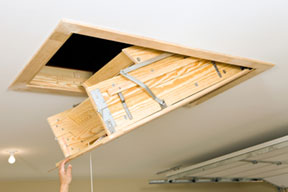 | (NewsUSA) - What homeowner wants to brave the winter elements to check on the health of his roof? And yet, given the crucial role roofs play in determining a house's efficiency -- yes, that means utility bills -- most people think they have no choice but to go mano a mano with all that snow and ice. Turns out most people are wrong. You could just check your attic instead. "Roofs create an insulated barrier that helps trap heat inside," says Jason Joplin, program manager of the Center for the Advancement of Roofing Excellence, which is championed by GAF, North America's largest roofing manufacturer. "And since most attic spaces are located right below them, it's a convenient spot to see potential problem areas and damage without being subjected to falls and injury." Here are some tips on what to look for: * Animal damage. The telltale signs that birds, bats, squirrels and raccoons have found refuge in your attic should set off alarm bells, given the havoc they can wreak. So if you do spot anything suspicious -- including nests, droppings and gnawed wood, wires or insulation -- call a pest professional immediately. * Leaks. As sure as the TSA will keep hassling grandmothers, it will soon storm. And when it does, shine a flashlight up in the attic in search of not just dripping water and condensation, but also water stains on the ceiling, walls and floor. Those are sure indications that H2O is unfortunately finding its way under your roof's shingles or behind its flashings. * Ventilation. "The attic is like the lungs of the house," says Joplin. "It must be able to breathe in order to function properly." Ergo, if your vents are stuffed with debris, they need to be cleared. * Structure. Now that you're in the attic, take a look up. Are sections of the roof sagging? If so, that signals potential structural weakness requiring professional repair. Of course, for those who insist on venturing outside in the cold, here's a final tip to file under the category of Why Didn't I Think Of That Myself?: You can still check for structural deformities without climbing any treacherous ladders by using binoculars to zoom in -- from the safety of the ground -- on everything from loose shingles to broken gutters. And if you're truly interested in prolonging your roof's life, experts say it pays to consult a professional roof contractor who's insured and uses quality materials like GAF's Timberline American Harvest shingles. A free service that makes it easy to find a factory-certified contractor in your area can be found at www.gaf.com. |
Thursday, November 1, 2012
Winter Roof Maintenance: Your Attic's Hidden Secrets
Subscribe to:
Post Comments (Atom)

No comments:
Post a Comment